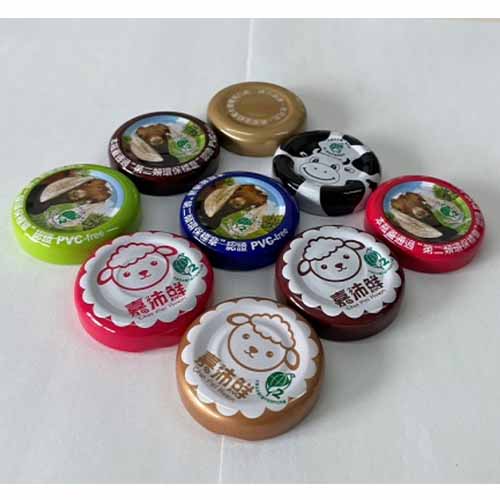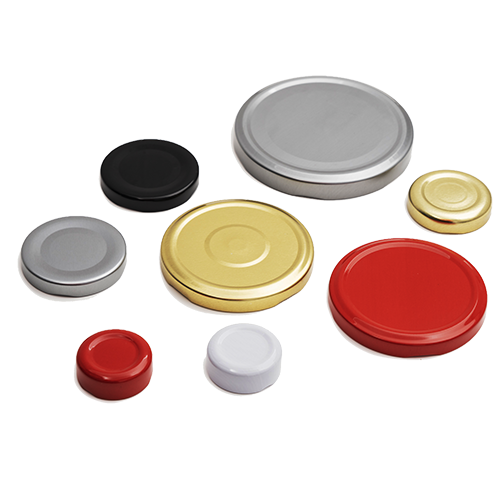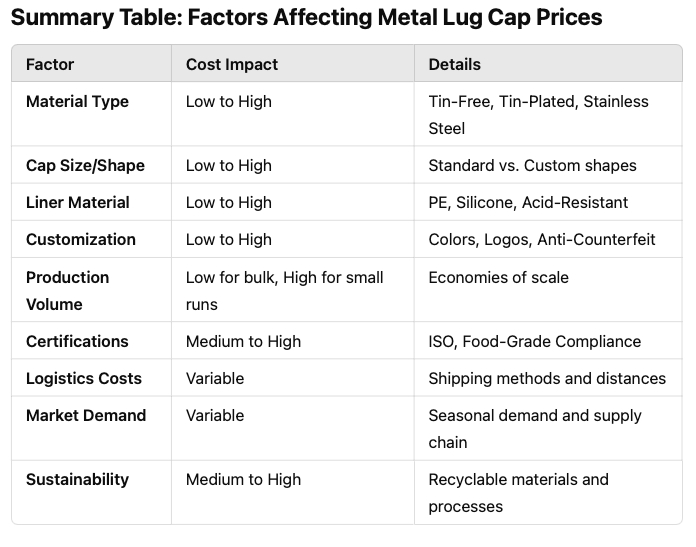What Factors Affect the Price of Metal Lug Caps?
What Factors Affect the Price of Metal Lug Caps?
The price of Metal Lug Caps is influenced by a variety of factors, ranging from material selection and customization options to production processes and market dynamics. Understanding these factors can help businesses make informed decisions when sourcing Metal Lug Caps. Below, Kamellia breaks down the key factors that determine the cost of Metal Lug Caps.
1. Material Type
The material used in manufacturing Metal Lug Caps significantly impacts the price. Common materials include:
- Tin-Plated Steel: Affordable, durable, and widely used.
- Tin-Free Plated Steel (TFS): Cost-effective and suitable for general packaging but slightly less durable in acidic environments.
- Stainless Steel: Premium material with superior corrosion resistance, but it comes at a higher cost.
- Aluminum: Lightweight, corrosion-resistant, and aesthetically pleasing, but generally more expensive.
Material Impact on Price:
- Lowest Cost: Tin-Free Plated Steel
- Mid-Range Cost: Tin-Plated Steel
- Higher Cost: Aluminum
- Premium Cost: Stainless Steel
Kamellia offers Tin-Plated Steel and Tin-Free Plated Steel options to balance performance and cost.

2. Cap Size and Shape
The size and shape of the cap directly affect material consumption and manufacturing complexity.
- Standard Sizes (e.g., 38mm, 43mm, 53mm, 63mm): More cost-effective due to mass production.
- Custom Sizes or Shapes: Require custom molds and tooling, increasing costs.
Cost Impact:
- Standard Sizes: Lower cost per unit due to scalability.
- Custom Shapes/Sizes: Higher cost due to unique mold development and smaller production batches.
-

3. Liner Material
The type of liner used inside the Metal Lug Cap affects sealing performance and cost.
- PVC Liner: Affordable and effective for most food and beverage products.
- Silicone Liner: More expensive but suitable for high-temperature sterilization.
- Acid-Resistant Liner: Specialized and costs more due to chemical resistance requirements.
Cost Impact:
- Low Cost: Standard PE Liners
- Mid-Range Cost: Specialized PE Liners
- High Cost: Silicone or Acid-Resistant Liners
Kamellia uses high-quality liners sourced from leading international chemical manufacturers to ensure reliable performance.
4. Customization Options
Customization enhances branding but adds to the production cost:
- Color Customization: Standard colors are more cost-effective; custom Pantone matching may incur extra costs.
- Logo Printing: Multi-color or complex designs increase printing costs.
- Surface Finishes: Matte, glossy, or textured finishes vary in cost.
- Embossing/Debossing: Requires additional tooling and labor.
- Anti-Counterfeit Features: QR codes, holograms, and tamper-evident seals add to costs.
Cost Impact:
- Basic Design (Single Color, Standard Print): Lower cost.
- Mid-Level Design (Custom Colors, Multi-Color Print): Moderate cost.
- High-Level Design (Embossing, Holographic Features): Higher cost.
5. Production Volume
Production volume is a critical factor in determining unit costs.
- Large Batch Production: Lower per-unit cost due to economies of scale.
- Small Batch Production: Higher per-unit cost due to fixed tooling and setup costs.
Cost Impact:
- Bulk Orders: Lower price per unit.
- Small Orders: Higher price per unit.
Kamellia offers flexible production runs to accommodate both bulk and small-batch requirements.
6. Manufacturing Process and Technology
The production techniques and machinery used influence costs:
- Automation: Fully automated production lines reduce labor costs and improve efficiency.
- Manual Processing: Increases labor costs, especially for complex customizations.
- Quality Control: Strict quality inspection standards may add to costs but ensure consistency.
Cost Impact:
- Highly Automated Production: Cost-efficient for large volumes.
- Manual Customization: Higher costs for small, intricate runs.
Kamellia employs advanced production technology and strict quality control to balance cost and product quality.
7. Certifications and Compliance
Certifications ensure product safety and quality, but achieving these standards adds costs:
- ISO 9001:2015 Certification: Ensures consistent product quality and management.
- Food-Grade Certification: Compliance with food safety standards increases production costs.
- Sustainability Standards: Eco-friendly manufacturing practices can add costs.
Cost Impact:
- Basic Compliance: Standard cost.
- Premium Compliance (Multiple Certifications): Higher cost.
All Kamellia Metal Lug Caps are ISO 9001:2015 certified and meet international quality standards.
8. Transportation and Logistics Costs
Shipping and logistics contribute significantly to the final price:
- Domestic Shipping: Lower transportation costs.
- International Shipping: Higher costs due to customs, tariffs, and freight charges.
- Urgent Delivery: Expedited shipping increases costs.
Cost Impact:
- Standard Shipping: Cost-efficient.
- Express Delivery: Higher cost.
Kamellia ensures optimized logistics solutions to minimize shipping costs for customers worldwide.
9. Market Demand and Supply Chain Stability
Market factors, such as fluctuations in raw material prices or global supply chain disruptions, can also impact pricing:
- Raw Material Costs: Rising steel or aluminum prices affect cap costs.
- Market Demand: Higher demand during peak seasons may increase costs.
- Global Events: Supply chain disruptions can lead to cost spikes.
Kamellia maintains a stable supply chain to ensure consistent pricing and reliable deliveries.
10. Sustainability Initiatives
Environmentally friendly production practices can add costs:
- Recyclable Materials: Slightly higher initial costs but align with sustainability goals.
- Waste Management Systems: Eco-friendly disposal processes add overhead costs.
Kamellia prioritizes sustainable manufacturing to meet global environmental standards.
Summary Table: Factors Affecting Metal Lug Cap Prices
|
Factor |
Cost Impact |
Details |
|
Material Type |
Low to High |
Tin-Free, Tin-Plated, Stainless Steel |
|
Cap Size/Shape |
Low to High |
Standard vs. Custom shapes |
|
Liner Material |
Low to High |
PVC, Silicone, Acid-Resistant |
|
Customization |
Low to High |
Colors, Logos, Anti-Counterfeit |
|
Production Volume |
Low for bulk, High for small runs |
Economies of scale |
|
Certifications |
Medium to High |
ISO, Food-Grade Compliance |
|
Logistics Costs |
Variable |
Shipping methods and distances |
|
Market Demand |
Variable |
Seasonal demand and supply chain |
|
Sustainability |
Medium to High |
Recyclable materials and processes |

Why Choose Kamellia?
- Material Versatility: Tin-Plated and Tin-Free Plated Steel options.
- High-Quality Customization: Colors, logos, finishes, and liners.
- Flexible Production: Suitable for both bulk and small batches.
- ISO 9001:2015 Certified: International quality standards.
- Sustainability Commitment: Eco-friendly manufacturing practices.
- Global Logistics Support: Reliable and cost-efficient shipping.
Explore our Metal Lug Caps:
Contact Kamellia Today to discuss your specific requirements and receive a custom quote tailored to your needs!
◎ More Metal Lug Cap FAQ:
1 How Do Lug Caps Ensure Airtightness and Leak-Proof Performance?
2 What Types of Containers Are Suitable for Lug Caps?
4 What Are the Material Options for Metal Lug Caps? Which Material is Best for My Product?
6 What are MTO Metal Lug Caps and MTP Metal Lug Caps? What are the differences between MTO and MTP?
7 Maximizing Product Safety with Safety Buttons on Metal Lug Caps
8 Choosing Between Screw Caps and Lug Caps: Differences and Applications
9 How to choosing a metal lug cap manufacturer?
10 What customization options are available for metal lug caps?
11 What materials are used for metal lug caps? How do I choose the right material?
The price of Metal Lug Caps depends on materials, customization, production volume, and logistics. Kamellia offers cost-effective solutions, including Tin-Plated and Tin-Free Steel options, tailored to your needs. Contact us today for premium and flexible lug cap solutions!
